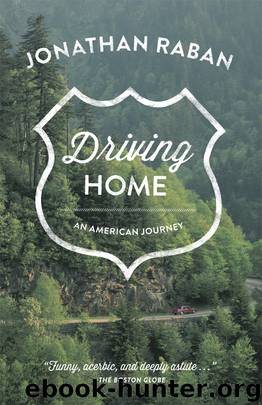Driving Home by Jonathan Raban

Author:Jonathan Raban [Raban, Jonathan]
Language: eng
Format: epub
ISBN: 978-1-57061-884-0
Publisher: Sasquatch Books
Published: 2013-07-30T04:00:00+00:00
To which he added the characteristic footnote: “It is true about the old dog, at least I saw it reported somewhere.”
New York Review of Books, November 2000
Battleground of the Eye
LANDSCAPE—if you give that rather slippery term its full weight—is one of the great divisive issues in the Pacific Northwest. The landscape paintings of the region, from the eighteenth century to the present day, are pictorial dispatches from a long war that is more heated now than at any time in the past two hundred years.
Landscape is land shaped—land subordinated to a vision or a use. A picture frame or a Claude glass* converts land into landscape; so, too, does a logging road or a barbed-wire fence. The railroad magnate and the painter of majestic wilderness scenes have in common their designs on the land: James J. Hill and Albert Bierstadt are brothers under the skin.
Consider this curious tale of two pictures of the Pacific Northwest. In 1999 Slade Gorton, the Republican senator from Washington State, tacked an ingenious rider onto a bill intended to provide American aid for Kosovo. His rider concerned a proposed cyanide-leach goldmine in Okanogan County (he was for it). Eighteen months later, in the race between Gorton and his Democratic challenger, Maria Cantwell, this came back to haunt him. It probably lost him the election, which Cantwell won by a hair, after a string of recounts.
In the Gorton–Cantwell race, landscape turned into the central topic of debate, as the candidates fought over such questions as the Okanogan County mine, logging in national forests, and the breaching of dams on the Snake River. From the barrage of television ads that were broadcast by both sides, two pictures emerged, each executed in a style familiar to any Northwest gallery-goer. Gorton’s was a tame Augustan landscape, with irrigated farms and gardens and orderly plantations, in which nature was tailored to human needs and specifications. Cantwell’s was a landscape in the manner of Bierstadt or Thomas Cole—a Romantic wilderness, with free-swimming salmon and untouched stands of tangled old-growth forest where spotted owl called to spotted owl, a realm of aboriginal solitude and grandeur.
Rural voters east of the Cascade Mountains showed an overwhelming preference for the Gorton picture, with its promise of money and jobs. West of the mountains, along the urban corridor that stretches north and south from Seattle, the Cantwell landscape found favor with hikers, birdwatchers, fly fishers, and the mass of college-educated white-collar voters, who bear out the interesting paradox that Seattle is the first big city to which people have swarmed in order to get closer to nature.
One might hear echoes of that debate almost anywhere in the United States, but in the Pacific Northwest it is conducted with a peculiar and obsessive intensity, because here the wilderness itself seems to possess a tenacious memory. In this damp, dauntingly fertile climate the creeping salal and salmonberry, and the green spears of infant Douglas firs, are bent on restoring everyone’s back yard to the temperate rainforest that it was not so long ago.
Download
This site does not store any files on its server. We only index and link to content provided by other sites. Please contact the content providers to delete copyright contents if any and email us, we'll remove relevant links or contents immediately.
The Rules Do Not Apply by Ariel Levy(3909)
Bluets by Maggie Nelson(3718)
Too Much and Not the Mood by Durga Chew-Bose(3697)
Pre-Suasion: A Revolutionary Way to Influence and Persuade by Robert Cialdini(3419)
The Motorcycle Diaries by Ernesto Che Guevara(3340)
Walking by Henry David Thoreau(3236)
What If This Were Enough? by Heather Havrilesky(2946)
The Day I Stopped Drinking Milk by Sudha Murty(2857)
Schaum's Quick Guide to Writing Great Short Stories by Margaret Lucke(2806)
The Daily Stoic by Holiday Ryan & Hanselman Stephen(2709)
Why I Write by George Orwell(2360)
Letters From a Stoic by Seneca(2335)
The Social Psychology of Inequality by Unknown(2312)
A Short History of Nearly Everything by Bryson Bill(2137)
Feel Free by Zadie Smith(2103)
Insomniac City by Bill Hayes(2086)
A Burst of Light by Audre Lorde(1981)
Upstream by Mary Oliver(1937)
Miami by Joan Didion(1883)
